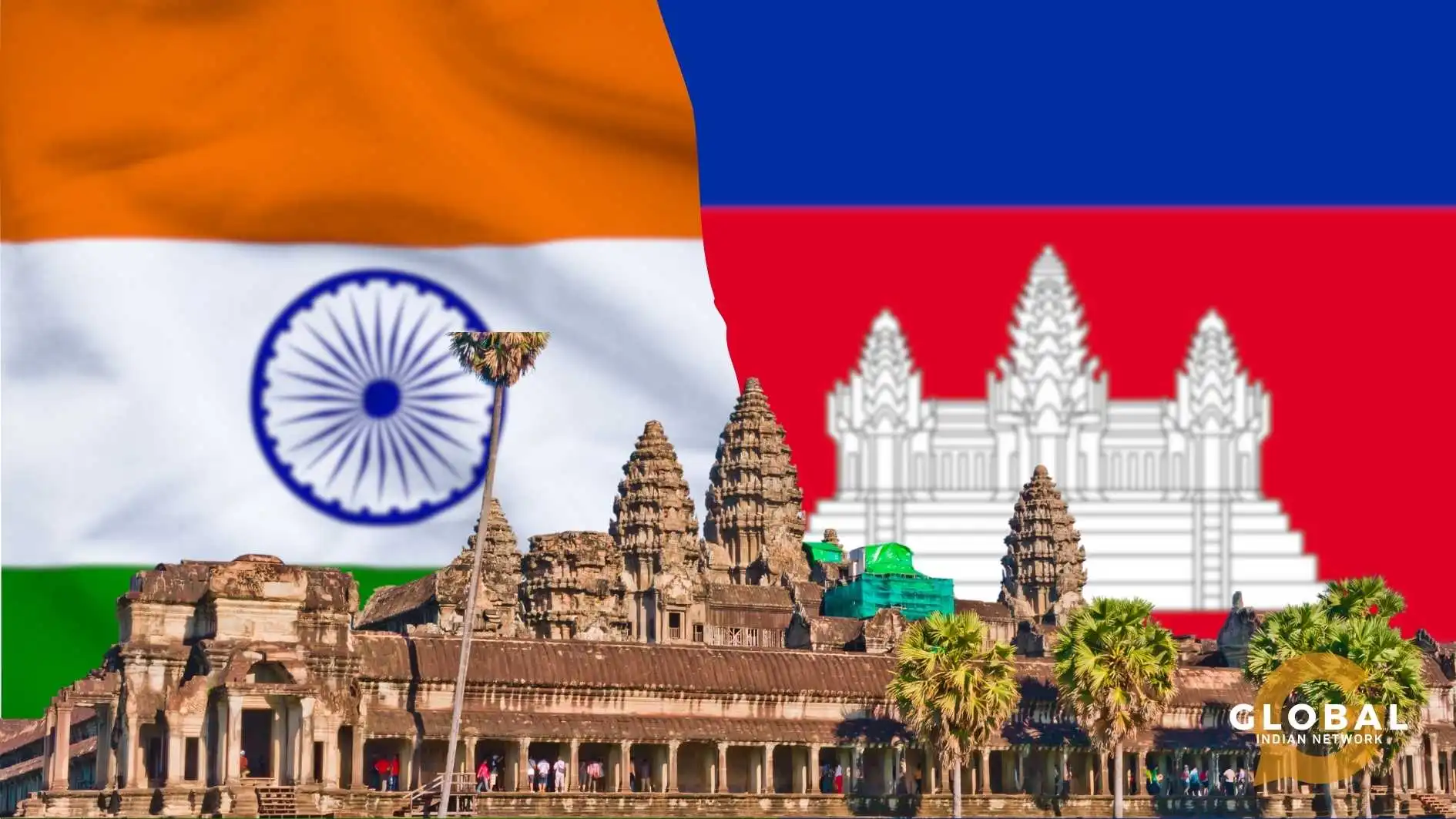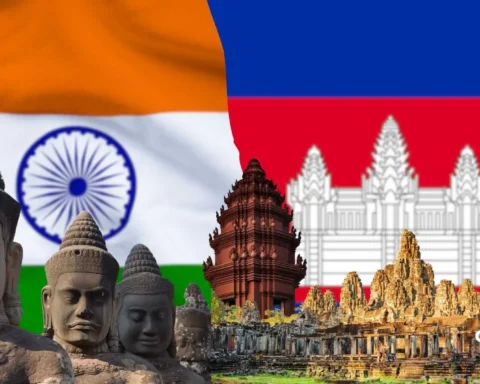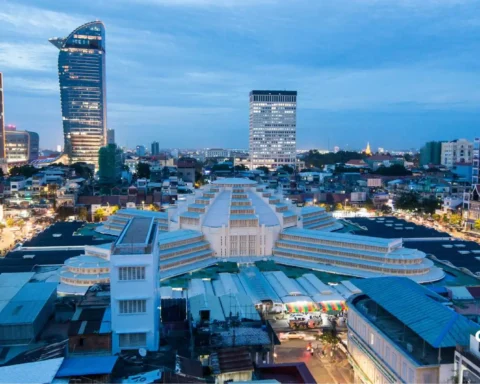The historical connection between India and Cambodia is one that stretches multiple centuries into the past, with archaeological evidence suggesting interaction since the first and third centuries Common Era. Indian culture in Cambodia is visible from the Hindu-style ancient temples of Angkor Wat and Angkor Thom, which are a derivative of the Pallava script from present-day southern India. In addition to this, there also exists the prevalence of several other pieces of evidence of the historical relations. Additionally, the presence of South Asian and Indian genetic ancestry in Cambodia suggests a historical Indian presence in the country.
In this article, we will explore the historical connection between India and Cambodia, examining how it has shaped both diplomatic and bilateral relations between the two countries, as well as several cultural exchange programmes that continue across both Asian countries.
Table of Contents
The Historical Connection Between India and Cambodia
Indian culture has been a mainstay in Southeast Asia since ancient times. The strong influence on Cambodian society is evident in many aspects of the Southeast Asia country. A good point of reference is in the written Khmer language, the national language of Cambodia, which has over 1000 loan words from the Indian language of Sanskrit.
The Cambodian people, who are now predominantly Buddhist, retain a strong influence of Indian Hindu and Buddhist rituals, idolatry and mythology, which can be seen in many of their rituals having resemblance with Indian culture and traditions. The Indian influence for centuries on Hinduism, Buddhism, and Indian architecture is also seen at the magnificent structures at Angkor Wat, Angkor Thom, Bayon, Ta Prohm, Bantey Srei and the many historical sites in Cambodia.

Cultural Exchange Programs Between India and Cambodia
Beyond ancient memory, India and Cambodia have maintained and fostered a strong bilateral relationship. A strong part of this relationship has been the ongoing project to ensure that these hallmarks of the historical connection between India and Cambodia remain.
For example, the Government of India, with the support of the Cambodian Ministry of Tourism and the Ministry of Education, Youth and Sports, has been organizing yoga events to celebrate International Day of Yoga (IDY) as a means of maintaining the cultural relationship between the two strategic partners in South East Asia. The 3rd IDY was celebrated in three cities of Cambodia in June 2017, which was attended by more than 2500 participants. In 2018, escalating the level of celebration of Yoga Day, the Embassy organized the celebration of International Yoga Day in four cities, namely Phnom Penh, Sihanoukville, Siem Reap and Battambang, which witnessed an increased number of attendees.
Similarly, the Festival of India, which included many events, including an event on the theme of Ramayana, which is a shared tradition of both India and Cambodia, further pushing the cultural diffusion between the two countries, was organized by the Embassy of India in Cambodia.
As a further means to strengthen the cultural bonds and historical connection between India and Cambodia. The Mekong Ganga Cooperation initiative was announced. The Mekong Ganga Cooperation has sprouted the subsequent MGC Asian Traditional Textiles Museum at Siem Reap, which is a unique repository of traditional textiles between India and countries in Southeast Asia, including Cambodia. It also has a training centre and workshop in textiles, a fashion design and development centre using traditional ethnic designs, and various children’s activities in the centre. It also helps preserve the age-old tradition of textiles in this region. The Museum is another attraction for tourists coming to Siem Reap.
How Cambodia and India’s Historical Connection Shapes the Present
India and Cambodia share a strong, positive relationship that dates back to the 1950s, with India’s early involvement in Cambodia’s post-colonial reconstruction. Following the fall of the Khmer Rouge regime, India became the first country to recognize Cambodia’s new government in 1981 and reopened its Embassy, which had been closed during the Khmer Rouge period. India also helped restore cultural heritage, including sending experts from the Archaeological Survey of India in 1986 to restore the aforementioned Angkor Wat.
Over the years, goodwill between the two nations has been bolstered by regular high-level visits, political exchanges, cultural diplomacy, and aid in developmental projects. India’s “Act East” policy and Cambodia’s role in ASEAN have led to deeper cooperation, particularly in human resource development, infrastructure, and defense. Notable visits from both countries have further strengthened ties, including visits by Indian leaders like Prime Minister Jawaharlal Nehru and President Pratibha Patil, alongside Cambodian Prime Minister Hun Sen’s state visit to India in 2018.
India has contributed to Cambodia’s socio-economic growth through various projects, such as the restoration of temples, capacity-building initiatives, and the establishment of the Asian Traditional Textile Museum. India continues to assist Cambodia with small-scale socio-economic projects, including health, agriculture, and sanitation, creating lasting and visible benefits for the Cambodian people.
Conclusion
The historical connection between India and Cambodia is a long-standing and ongoing one. Over millennia of interactions between the two societies have led to the fostering of a natural and holistic relationship between the two countries. This relationship, however, is not limited to history and culture. Several socio-economic initiatives exist between both countries, including university grants and scholarship grants for the citizens of the two countries, being among the many ways interactions between India and Cambodia have expanded beyond the pre-existing domains.

FAQs
Did the Cholas rule in Cambodia?
The Cholas ruled from the 3rd century B.C. until almost 1279. The Cholas ruled from the present-day state of Tamil Nadu. They had conquered most of eastern India, extending into Bangladesh, Burma, Thailand, Cambodia, Laos, Sri Lanka, the Maldives and Malaysia.
What Hindu God is the Angkor Wat Temple dedicated to?
The construction of the temple commenced in 1122 CE and was completed in 1150 CE. The temple complex was constructed on the suggestion of Divākarapaṇḍita (1040– c. 1120). The temple was dedicated to the Hindu god Vishnu, and the original religious motifs were derived from Hinduism.
Did Cambodians come from India?
Various genetic studies show that modern Cambodians have 9-19% Indian ancestry. The ancient fossils in Cambodia tell an even more surprising story. Half of the Cambodians were migrants from India during the period of 2000 BCE to 500 AD.









